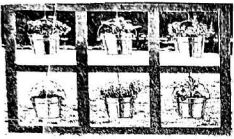- Contamination of soil with harmful substances and other materials like polythene papers and plastics is known as (1mks)
- Name 3 human activities that cause soil pollution. (3mks)
- Identify 2 structures used to collect surface run off water. (2mks)
- Name 3 minimum tillage practices that help to conserve water in farming. (3mks)
- What is agroforestry? (1mk)
- Wanjiru wanted to practice agroforestry. State 2 characteristics of trees he should establish in his farm. (2mks)
- What is a planting site? (1mk)
- Identify 2 types of planting sites. (2mks)
- Identify the following types of planting materials. (3mks)
- Identify the following methods of planting seeds (2mks)
- Name 3 factors that determine the appropriate time for planting. (3mks)
- Thinning and gapping are some of the practices done by farmers during crop management. Differentiate between thinning and gapping. (2mks)
Thinning
Gapping -
- What is animal handling? (1mks)
- Name 2 forms or ways of animal handling. (2mks)
-
- Otieno has a pet that he bought from an animal farm. Name other 3 ways otieno could have acquired the pet. (3mks)
- Name 3 factors that Otieno might have considered when selecting his pet. (3mks)
-
- Explain the meaning of sorting eggs? (1mks)
- Give 2 importances of processing honey. (2mks)
-
- What is off season cropping. (1mks)
- Give 3 importances of off-season cropping. (3mks)
- The picture below shows a type of garden constructed by grade 7 learners.
- What type of garden did the learner construct? (1mk)
- Name 3 factors that learners considered when selecting materials for constructing the garden. (3mk)
-
- The process of changing a product from its original state to a move suitable state is known as (1mk)
- Give 4 benefits of modifying a product from one state to another. (4mks)
MARKING SCHEME
- Soil pollution
-
- Dumping of plastic wastes
- Excessive use of fertilizers
- Excessive use of agrochemicals
- poor disposal of used chemical conatiners
-
- earth basin
- water retention ditches
- water retention pits
-
- mulching
- slashing
- uprooting weeds
- allowing livestock to feed on weeds
- Is the practise of growing crops, trees and rearing livestock in the same piece of land
-
- Fast growth rate
- deep rooted
- should have multiple uses
- be able to fix nitrogen into the soil
- Is an area in which crops are grown form planting materials until ready for harvesting or transplanting
-
- Groundsites
- Non-ground sites (container sites)
-
- seeds
- stem cuttings
- suckers
-
- Drilling
- Dibbling
-
- timed markest
- onset of the rain
- soil moisture
- Time of harvesting/weather condition
-
- Thinning - is the practise of uprooting excess seedlings from where the're overcrowded
- Gapping - The practise of replacing seeds that did not germinate or the seedlings that dried up.
-
- Animal handling refers to how people treat and act when working with animals/transporting animals.
-
- human
- inhuman
-
-
- gifts
- inheriting
- adopting
-
- social factors
- safety factors
- legal factors
- economic factors
- age
- health
-
-
- Refers to the process of separating eggs according to size, colour and shape.
-
- Stays fresh for a longer period/increases shelf life
- Mantains good flavour
-
- Refers to the production of crops after or before their normal season
-
- It ensures continous supply of food
- It ensures farmers get regulr income
- It ensures that crops attract high market prices
- It ensures food security
-
- framed suspended garden
-
- Purpose of the structure
- Availabilty of the materials
- Cost of the materials
- The space available
- The shape of the structure
-
- value addition
-
- To increase shelf life
- To improve taste
- To reduce spoilage
- To make it easy to market
Join our whatsapp group for latest updates
Tap Here to Download for 30/-
Get on WhatsApp for 30/-
Download Agriculture Questions and Answers - Grade 7 End Term 3 Exams 2023 Set 1.
Tap Here to Download for 30/-
Get on WhatsApp for 30/-
Why download?
- ✔ To read offline at any time.
- ✔ To Print at your convenience
- ✔ Share Easily with Friends / Students



